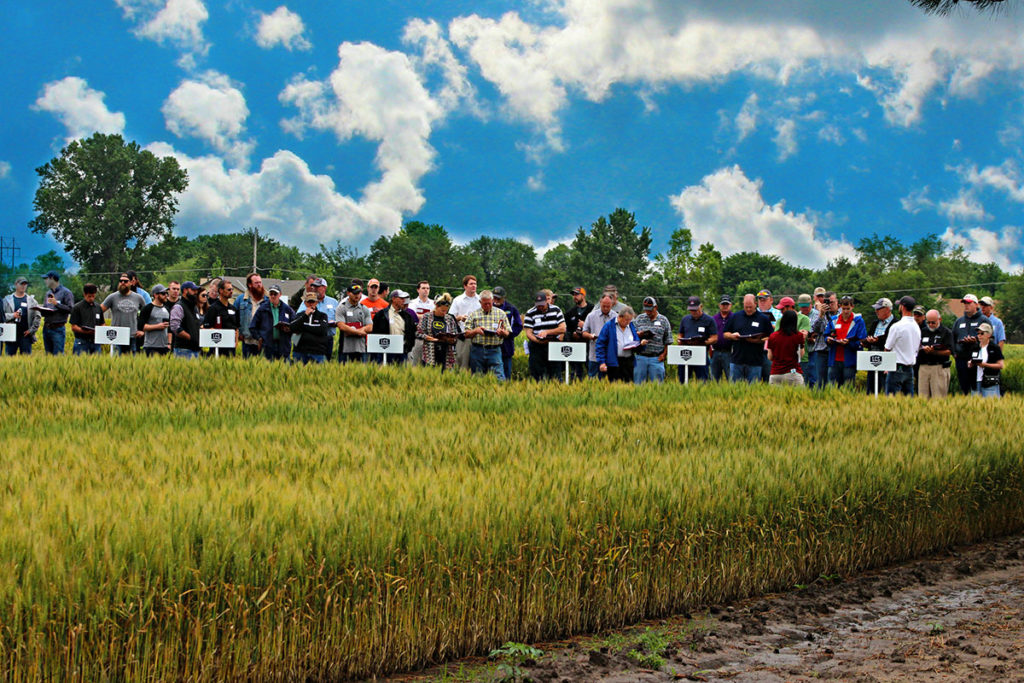High Plains Journal, Bill Spiegel May 28, 2017 — Limagrain Cereal Seeds is riding a wave of momentum in Kansas, having developed two of the state’s five most popular winter wheat varieties—T158 and LCS Mint—in 2017.
While the Fort Collins, Colorado-based wheat genetics firm continues its work on robust new Hard Red and Hard White winter wheat varieties throughout the High Plains, Limagrain believes its forthcoming herbicide resistant trait production system in winter wheat can be a game-changer.
Company officials talked about CoAxium, a collaboration between Limagrain, Albaugh, LLC and the Colorado Wheat Research Foundation, at its annual Central Plains Field Day near Wichita on May 19.
CoAxium is a production system that allows a Class I grass herbicide to be sprayed “over-the-top” of wheat varieties containing natural herbicide resistance, said Frank Curtis, chief operating officer for Limagrain. Grass weeds controlled include feral rye, jointed goatgrass, wild oats, cheat/downy brome and volunteer cereals.
“On those, there is amazing control. It is quite spectacular to see in the field,” he said. The herbicide also suppresses other grass species.
The CoAxium Wheat Production System is a combination of a patented herbicide trait, a new herbicide brand and a strong focus on industry stewardship, added Chad Shelton, global proprietary products director at Albaugh, LLC.
Albaugh, a leader in the production of post-patent herbicides, will supply the approved herbicide chemistry for the CoAxium system under a yet-to-be-determined name. The wheat varieties were developed at Colorado State University, are patented through the Colorado Wheat Research Foundation and will be licensed under its Plains Gold brand. Limagrain will move the herbicide resistance trait into the background of other wheat varieties, and take care of licensing and intellectual property management, Curtis said.
He added the CoAxium Wheat Production System is a naturally occurring trait. “This is a new concept, but it is not a genetically modified organism,” he said.
There will be a technology fee associated with CoAxium, but the overall cost of using the weed control product will be competitive with products currently on the market, Curtis said.
“Our objective is to make the trait fee plus the herbicide cost combined, competitive with other options on the market,” he said. “It isn’t going to cost more, but it will produce a better result.”
The herbicide should be registered this fall, with about 6,000 bushels of foundation seed released to growers for the 2018 wheat crop. Full product rollout is expected in 2018.
High amylose wheat in the offing
The company is working on development of several high-amylose wheat varieties, which would increase the fiber content of wheat by a value of 10, said Jim Peterson, head of research for Limagrain Cereal Seeds.
The high-amylose variety portfolio is unique to Limagrain, Peterson told sales associates in Wichita. The company is working with Arysta LifeSciences and Bay State Milling to bring these varieties to market.
With higher fiber content, high-amylose wheat can be a healthier ingredient choice in breads, cereals and other foods, with properties that can curb problems of Type II diabetes, the prevention of colorectal cancer and obesity, according to CSIRO Plant Industry, an Australian research group with which Limagrain is working.
“This is a value-added output trait and turns wheat into an ingredient, not just a commodity grain,” Peterson said.
